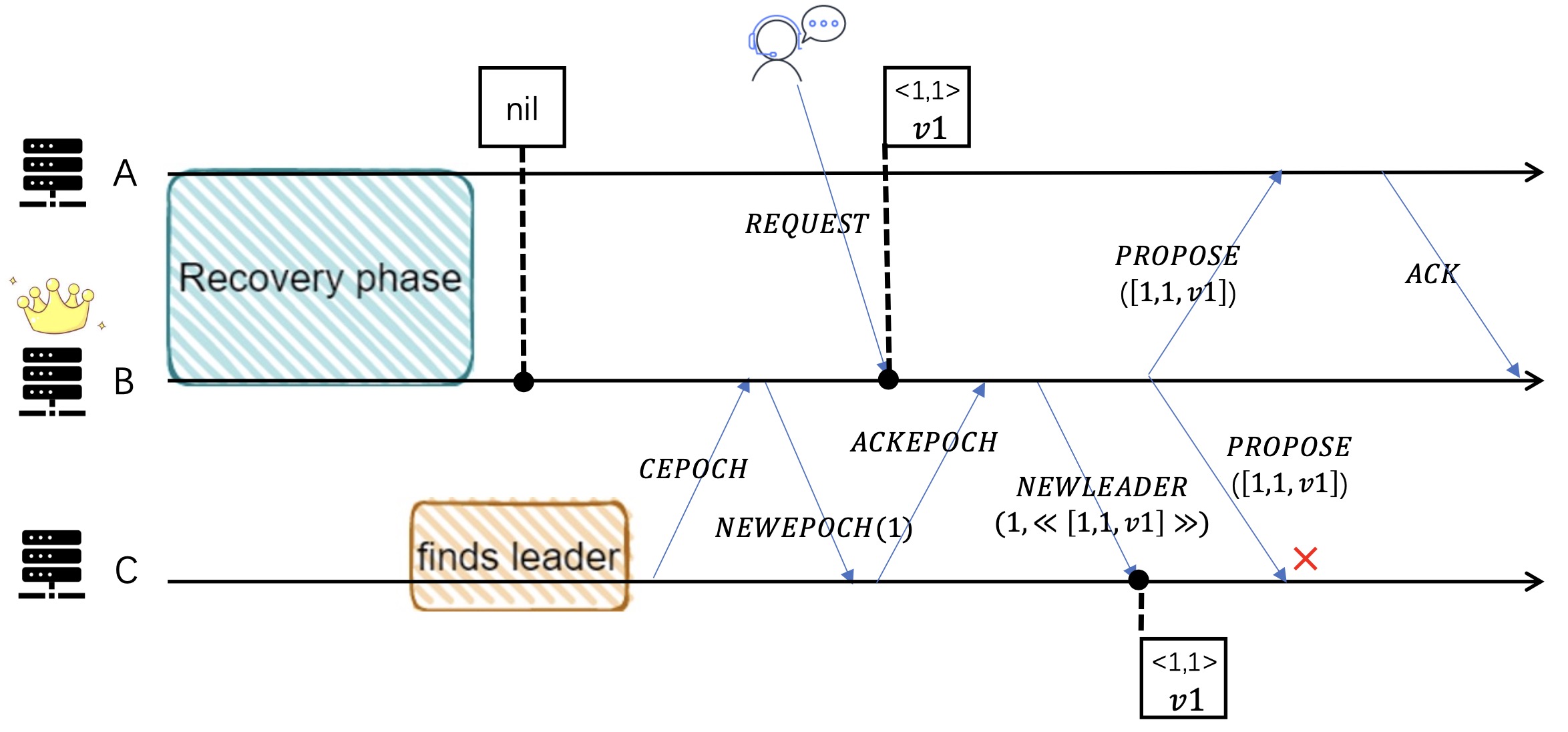issues.md 6.2 KB
Issues
This document describes issues related to the ambiguous description of the Zab protocol.
(Issue 1)Issue introduced by vague explanation of broadcast object set Q
Because the Leader will only accept the client request when it reaches the Broadcast stage, thus when Leader broadcasting messages from Broadcast stage, we naturally use the set ackldRecv as the object set when Leader broadcasting Propose and Commit messages in the initial protocol.
On this basis, the model checking found that there was an error in the protocol. After analyzing the execution path and the violated invariant, we located the error in the action FollowerProcessCommit. The Follower received an illegal COMMIT message, as shown in the figure below. In the COMMIT message, the log entry corresponding to the zxid does not exist in the local log.
A quorum of nodes including node A and node B completed the log recovery, and entered the Broadcast stage. Leader node B sent NEWLEADER(1, <[1, 1, v1]>) to node C, which joined the cluster. Then Leader B received client request and broadcast PROPOSE([1, 2, v2]). But node C did not receive the message because C is not in B's ackldRecv. Later, the Leader firstly processes ACK-LD from C and then ACK from A. So, the object of Leader B's broadcast COMMIT([1, 2]) contains C, and there is no log entry with zxid [1, 2] locally in C.
We found that because the set of objects when the Leader broadcast PROPOSE is ackldRecv, the Follower will not receive messages with type PROPOSE until receiving the COMMIT-LD. If a log entry is committed between the Leader sending NEWLEADER and COMMIT-LD, the corresponding receiver will permanently lose the log entry.
Therefore, we have made amendments in the spec. When the Leader broadcasts PROPOSE, the set of sending objects has been changed from ackldRecv to ackeRecv. We successfully discovered errors introduced by the vague description of Q in the protocol through model checking, and fixed them in the specification.
(Issue 2) Issue introduced by lack of client request logic
Since there is no descriptions about client request, we need to add a process that describes the Leader receives a client request and encapsulates the request as a new log entry and appends it to the local log. This process are represented as action LeaderProcessRequest in the spec.
In our original specification, when Follower receives the message PROPOSE, the zxid of the proposed log entry should be the successor zxid of the latest local log entry‘s zxid, otherwise it will be regarded as an illegal PROPOSE.
On this basis, model checking told us that there was an error in the model, as shown in the figure below, where Follower receives redundant PROPOSE from the same log entry.
A quorum of nodes including node A and B completed log recovery first and entered the Broadcast stage. When receiving a client request, Leader B encapsulated the request as a log entry [1, 1, v1]. Before B broadcast the proposal of the log entry, node C that joined the cluster later sent ACKEPOCH to B, and B replied with NEWLEADER(1, <[1, 1, v1]>), and added C to the set ackeRecv. So the PROPOSE([1, 1, v1]) broadcast by B was also sent to C, so C received the redundant proposal for the log entry [1, 1, v1].
We have analyzed two repair schemes. The first scheme is to atomize the actions LeaderProcessRequest and LeaderBroadcastPROPOSE and merge them into one action. The second scheme is to relax the constraints, where if the Follower receives redundant PROPOSE, it will be release this message directly. We chose the second scheme, because we think the situation is not serious and will not affect the correctness of Zab.
(Issue 3) Issue introduced by ambiguity of zxid in the message COMMIT-LD
When the Leader sends COMMIT-LD, the paper does not express the specific value of the zxid carried in the message. Therefore, we naturally set the zxid carried in COMMIT-LD to the zxid in ACK-LD.
Therefore, the model checking found an invariant violation, as shown in the figure below, the Follower received an illegal message COMMIT.
A quorum of nodes including node A and B completed log recovery first and entered the Broadcast stage. When the node C that joined the cluster later sent ACKEPOCH to Leader B, B sent NEWLEADER(1, <[1, 1, v1]>) to C, and then received the client request to broadcast PROPOSE([1, 2, v2]). Then, B received the message ACK([1, 2]) from A before receiving ACK-LD from C, so Leader B committed the log entry [1, 2, v2] and broadcasts COMMIT([1, 2]). Because the object set when broadcasting COMMIT is ackldRecv, C did not receive the commit message. Afterwards, B processed the ACK-LD([1, 1]) from C, and replied with COMMIT-LD([1, 1]). Therefore, when Leader B reached a consensus on the new log entry [1, 3, v3], it sendt COMMIT([1, 3]) to C, and C found that entry [1, 2, v2] in the local log has not been committed yet, which was treated as an illegal COMMIT.
The repair solution we analyzed is that in the action LeaderProcessACKLD, the zxid carried by COMMIT-LD is changed from the zxid in ACK-LD to the latest zxid committed locally by Leader, thus making up for the missing commit information.


